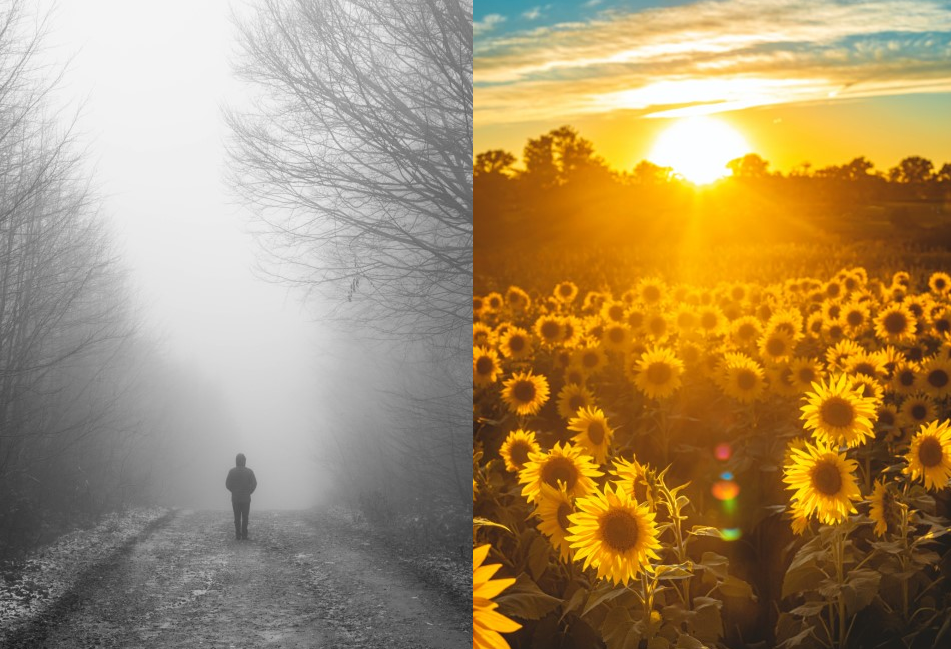When wet is dry and dry is wet



Consider a cold winters morning. There’s fog hanging in the air and it feels wet; there’s probably even dew on the ground. Now think of a beautiful summer morning. The sun is shining, there’s not a cloud in the sky and there’s no dew. Maybe it’s 5°C and 80% relative humidity outside in the winter situation. And 25°C and 40% relative humidity in the summer situaton. Which situation has more water in the air?
The answer surely is that there’s more water in the winter air. After all, it’s wet - you can see and feel the water. It’s intuitively obvious. But it’s wrong. Very wrong. In reality the winter air will be carrying 4.3 grams of water for every cubic metre of air but the summer air will be carrying 8.0 grams of water. And yet the relative humidity of the summer air (40%) is half that of the winter air (80%). What is going on?
The answer is that the vapour carrying capacity of air is related to the temperature of the air. Put simply: warm air can hold a lot more water than cold air. The absolute humidity is how much water vapour is in the air. The relative humidity is different; it’s a measure of how much water vapour is in the air relative to the maximum amount of vapour the air can hold at a specific temperature. As the relative humidity increases beyond about 80% the air gets close to saturation; it can’t hold the water as vapour anymore and so some of it condenses to liquid. We may see that as fog or mist, or sitting on the ground as dew.
What does this mean for buildings?
It means lots of things, but here’s just some (with a focus on winter heating in cool climates):
- If you want to reduce the chance of condensation and mould heat1 your building in winter! By heating you’ll increase the water vapour carrying capacity of the air so condensation will be less likely to occur. This is by far the easiest thing to do, but it won’t be cheap if the home is poorly insulated.
- Make sure all surfaces to which indoor air circulate are well above the dew point temperature. The dew point is the saturation temperature, or when the relative humidity is 100%. This means continuous insulation around the building, especially at cold spots like corners and where there’s structure like steel that conducts heat really well.
- Prevent warm indoor air escaping into the walls and roofspace through gaps like skirting boards, powerpoints and plumbing. This can be as simple as DIY caulking and expanding foam.2
- If your walls are poorly insulated don’t place furniture against the walls as that’ll reduce air circulation and make the walls even colder than they would otherwise be.
- Build tight, ventilate right. This mantra should be ingrained into the training for every builder and architect - you’ve got to build tight to prevent water-laden air getting deep into the building fabric where it’ll condense and use proper mechanical ventilation to ensure vapour from cooking, showering and general perspiration is adequately extracted.
 {width=100%}
{width=100%}
The magic of the relationship between temperature and the vapour-carrying capacity of air is best illustrated on a psychrometric chart. There’s plenty of online information about these but my favourite is https://drajmarsh.bitbucket.io/psychro-chart2d.html.
-
There’s a trick here though, as you want to heat the right way - if you burn stuff, like having a gas heater or a wood fireplace, the combustion process creates water vapour. So you’ll be adding absolute humidity as well as increasing temperature. It’s far, far better to heat without adding water vapour - the best choice by far is a split system (also known as a reverse cycle air conditioner or air source heat pump), followed by resistive electric heating and heat sources where the boiler is outdoors like a gas-fired hydronics system. ↩︎
-
Neither of these are adequate for a new building, and especially not a Passive House, but as a bandaid solution to an existing home they can be very cost effective. ↩︎
